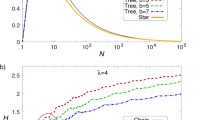Abstract
Generalized Farey tree network (GFTN) and generalized Farey organized pyramid network (GFOPN) model are proposed, and their topological characteristics are studied by both theoretical analysis and numerical simulations, which are in good accordance with each other. Then weighted GFTN is studied using cumulative distributions of its Farey number value, edge weight, and node strength. These results maybe helpful for future theoretical development of hybrid models.
Similar content being viewed by others
References
S. H. Kim and S. Ostlund, Simultaneous rational approximations in the study of dynamical systems, Physical Review A, 1986, 34: 3426–3434.
J. Maselko and H. L. Swinney, A Farey triangle in the belousov-zhabotinskii reaction, Physical Letter A, 1987, 119: 403–406.
J. Q. Fang, Generalized farey organization and generalized winding number in a 2-D DDDS, Physical Letter A, 1990, 146: 35–44.
O. Calvo, J. H. E. Cartwright, D. L. Gonzalez, et al., Three-frequency resonances in coupled phase-locked loops, Circuits and Systems I: Fundamental Theory and Applications, IEEE Transactions, 2000, 47(4): 491–497.
J. Q. Fang, X. F. Wang, Z. G. Zheng, et al., New interdisciplinary science: Network science (I), Progress in Physics, 2007, 27(3): 239–343.
J. Q. Fang, X. F. Wang, Z. G. Zheng, et al., New interdisciplinary science: Network science (II), Progress in Physics, 2007, 27(4): 361–448.
Z. Oltvai and Barabasi, Life’s complexity pyramid, Science, 2002, 298(5594): 763–764.
J. Q. Fang, Network complexity pyramid with five levels, Int. J. Systems, Control and Communications, 2009, 1(4): 453–477.
J. Q. Fang, Briefly review on complex network pyramid and their universality-complexity, in Proceedings of CCAST (WL) Workshop Series: Forth National Forum on Network Science and Graduate Student Summer School (ed. by J. Q. Fang), CCAST, Beijing, 2008, 191: 204–221.
J. Q. Fang and Y. Li, One kind of network complexity pyramid with universality and diversity, in Complex 2009 (ed. by J. Zhou), Part I, LNICST, 2009, 4: 78–89.
J. Q. Fang, X. F. Wang, and Z. G. Zheng, Dynamical complexity of nonlinear networks, Progress in Physics, 2007, 29(1): 1–74.
M. E. J. Newman, Assortative mixing in networks, Physical Review Letters, 2002, 89: 208701.
J. Q. Fang and Y. Liang, Topological properties and transition features generated by a new hybrid preferential model, Chinese Physics Letters, 2005, 22: 2719–2722.
J. Q. Fang, Q. Bi, and Y. Li, Toward a harmonious unifying hybrid model for any evolving complex networks, Advances in Complex Systems, 2007, 10(2): 117–141.
J. Q. Fang, Q. Bi, Y. Li, et al., A harmonious unifying preferential network model and its universal properties for complex dynamical network, Science in China Series G, 2007, 3(2): 230–249.
J. Q. Fang, Q. Bi, Y. Li, et al., A harmonious unifying preferential network model and its universal properties for complex dynamical network, Science in China Series G, 2007, 50(3): 379–396.
J. Q. Fang, Q. Bi, Y. Li, et al., Sensitivity of exponents of three-power-laws to hybrid ratio in weighted HUHPM, Chinese Physics Letters, 2007, 24(1): 279–282.
X. B. Lu, X. F. Wang, X. Li, and J. Q. Fang, Topological transition features and synchronizability of a weighted hybrid preferential network, Physica A, 2006, 370: 381–389.
Y. Li, J. Q. Fang, Q. Bi, and Q. Liu, Entropy characteristic on harmonious unifying hybrid preferential networks, Entropy, 2007, 9: 73–82.
Q. Bi and J. Q. Fang, Entropy and HUHPM approach for complex networks, Physica A, 2007, 383: 753–762.
J. Q. Fang, Q. Bi, and Y. Li, From a harmonious unifying hybrid preferential model toward a large unifying hybrid network model, International Journal of Modern Physics B, 2007, 21(30): 5121–5142.
J. Q. Fang, Q. Bi, and Y. Li, Advances in theoretical models of network science, Frontiers of Physics in China, 2007, 1: 109–124.
Y. Li, J. Q. Fang, and Q. Liu, Exploring theoretical model of network science and research progresses, Science & Technology Review, 2007, 25(11): 23–29.
J. Q. Fang, Exploring Theoretical model of network science and research progresses, Science & Technology Review, 2006, 24(12): 67–72.
J. Q. Fang, Theoretical research progress in complexity of complex dynamical networks, Progress in Nature Science, 2007, 17(7): 841–857.
J. Q. Fang, Theoretical research progress in complexity of complex dynamical networks, Progress in Nature Science, 2007, 17(7): 761–774.
J. Q. Fang and Y. Li, Transition features from simplicity-universality to complexity-diversification under the UHNM-VSG, Commun. Theor. Phys., 2010, 53(2): 389–398.
J. Q. Fang, Y. Li, and Q. Bi, Unified hybrid variable speed growth model and transition of topology property, Complex Systems and Complexity Science, 2008, 5(4): 56–65.
J. Q. Fang and Y. Li, Advances in unified hybrid theoretical model of network science, Advances in Mechanics, 2008, 38(6): 663–678.
J. Laherrèrel and D. Sornette, Stretched exponential distributions in nature and economy: Fat tails with characteristic scales, European Physical Journal B, 1998, 2(4): 525–539.
Author information
Authors and Affiliations
Corresponding author
Additional information
This research is supported by the Nature Science Foundation of China under Grand Nos. 70431002, 60874087, 60773120, and 10647001 and the Nature Science Foundation of Beijing under Grand No. 4092040.
Rights and permissions
About this article
Cite this article
Li, Y., Fang, J. & Liu, Q. From unweighted to weighted generalized Farey organized tree and the pyramid networks. J Syst Sci Complex 23, 681–700 (2010). https://doi.org/10.1007/s11424-010-9166-6
Received:
Published:
Issue Date:
DOI: https://doi.org/10.1007/s11424-010-9166-6




